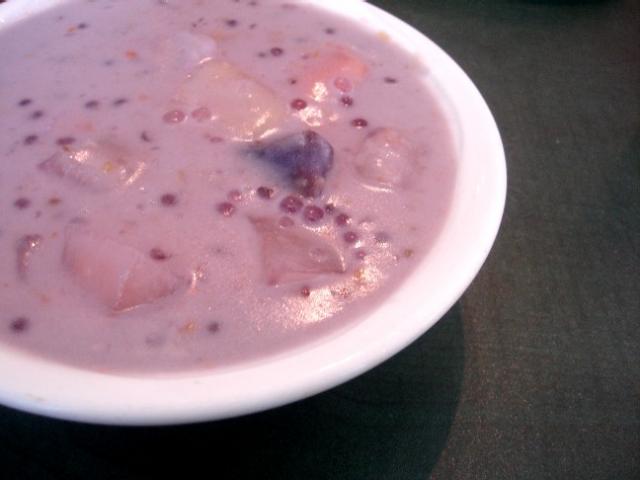Asian Sweets Ginataang Biography
Source(google.com.pk)
They say the number eight is an auspicious number. In Chinese culture, particularly, there is a special affinity to the number eight, not only because it sounds similar to the word meaning prosper or wealth, but also because the digits 88 share a resemblance to the characters depicting double joy or happiness.
I find the number eight meaningful because I was eight years old when my little sister was born. Eight years. A large enough age gap where I loved playing little mommy with my new sibling. Enough time for an older sister to grow up just enough to guide a little sister through life. And time enough for one to truly appreciate the blessing of getting the little sister I always wanted.
I love my sister, she’s my best friend. She loves my children almost as much as I do. Only trouble is, we live a six hour flight apart, and our sisterly bonding time is resigned to yearly visits, phone calls (lots of them), and family weddings. But when we do see each other, it is definitely a joy. Double joy.
What I miss most is Christmas with my sister. I miss sitting around in our comfy clothes, forming little sweet balls of glutinous rice for a dessert that has become our own little holiday tradition.
When my sister came to spend a whole week with us last month, I couldn’t wait to see her, and I knew right away what we must do. We were going to have our own Christmas in February and make Ginataang Bilo-Bilo. Translated quite literally, it means Balls Cooked in Coconut Milk (Gata). This Filipino dessert is like a coconut tapioca pudding, studded with delightfully chewy orbs of glutinous rice dumplings, Saba bananas, and jackfruit. Served warm, the scent of coconut is intoxicating, and the creamy spoonfuls are pure comfort. As soon as I knew my sister was coming, I bought a box of sweet rice flour in anticipation.
I think the weather knew what we were up to. Her arrival was marked by torrential rains and dismally gloomy, cold weather. But it was alright. In our cozy clothes, we were eager to share this dessert with the next generation. My daughter is now eight herself, and we couldn’t wait to teach her how to form the dough into those blobs of chewy delight. Seeing her sit with my sister at the table with handfuls of dough made me so happy, as I stirred the pot of sweetened coconut milk on the stove.
Passing on this tradition to my own little ones was poignant for both my sister and I; watching their reactions to their first sweet spoonfuls brought us true joy. It was the best Christmas present I could ask for.
Ginataang Bilo-Bilo {Filipino Coconut Tapioca Pudding with Glutinous Rice Balls}
Serves 10-12.
For the Bilo-Bilo:
1 1/2 cups sweet glutinous rice flour
1/2 to 3/4 cups water
For the Ginataan:
3 13.5-oz cans of coconut milk (gata)
2.5 cups of water (or simply, use 1 1/2 coconut milk cans)
8 oz small pearl tapioca
3 Saba bananas, sliced (if you can’t find Saba bananas, substitute 2 very ripe plantains or 3 medium standard bananas)
1 20-oz can of langka (jackfruit), sliced
1 1/3 cups granulated sugar
Form the Bilo-Bilo by combining the rice flour and water in a small bowl until you have a smooth dough. Form into balls no larger than 1/2 inch in diameter. Set aside.
In a large pot over medium heat, bring the coconut milk and water to a bubbling simmer.
Meanwhile, bring a large pot of water to a boil and cook the tapioca, stirring frequently. Drain and set aside.
Add bananas and langka to the simmering coconut milk. Add sugar and sweeten to taste. When the bananas are fork tender, add the tapioca, as well as the bilo-bilo one at a time to prevent sticking. You will know the bilo-bilo is cooked when they float to the top and are chewy to taste.
Ingredients:
5
Units: US | Metric
1 1/2 lbs sweet potatoes (buy a mix of yellow-flesh sweet potatoes and orange-flesh "yams")
1 saba banana, sliced bite-sized (buy at Asian market)
2 cups water
1/3 cup mochiko sweet rice flour
2 tablespoons water (or as needed)
14 ounces coconut milk (do not use Cream of Coconut) or 14 ounces light coconut milk (do not use Cream of Coconut)
1/2 cup sugar.
Directions:
1
Wash and peel sweet potatoes and cut into 1-1/2 inch pieces. Keep cut potatoes under water in a prep bowl while you are preparing so they don't discolor.
2
Drain potatoes and transfer to a large saucepan. Add the sliced Saba. Pour in 2 cups water and bring to boil over medium-high heat. Cook until the potatoes are fork-tender.
3
While potatoes and Saba are cooking, make the bilo bilo: In a small bowl, mix together the Mochiko flour and 2 tablespoons of water. Add more water as needed to make a dough that is not too sticky, not too dry. Roll into marble-size balls and set aside.
4
When potatoes are done, lower the heat to medium and gently drop the balls in the simmering water. They are fully cooked when they float to the top.
5
When the last ball floats, gently stir in the coconut milk and sugar to the mixture. Stir carefully so you don't break up the potatoes. Simmer for 5 minutes, then ladle into bowls and serve warm.
6
Store leftovers in fridge; reheat before serving.
Asian Sweets Ginataang

Asian Sweets Ginataang

Asian Sweets Ginataang

Asian Sweets Ginataang

Asian Sweets Ginataang

Asian Sweets Ginataang

Asian Sweets Ginataang

Asian Sweets Ginataang
Asian Sweets Ginataang

Asian Sweets Ginataang

Asian Sweets Ginataang

Asian Sweets Ginataang

Asian Sweets Ginataang

No comments:
Post a Comment